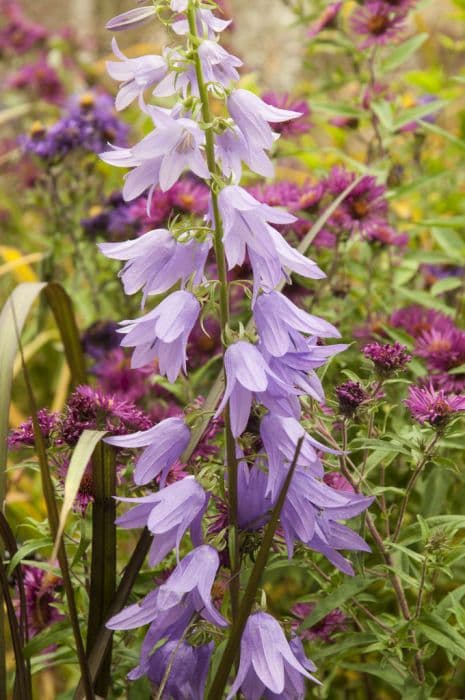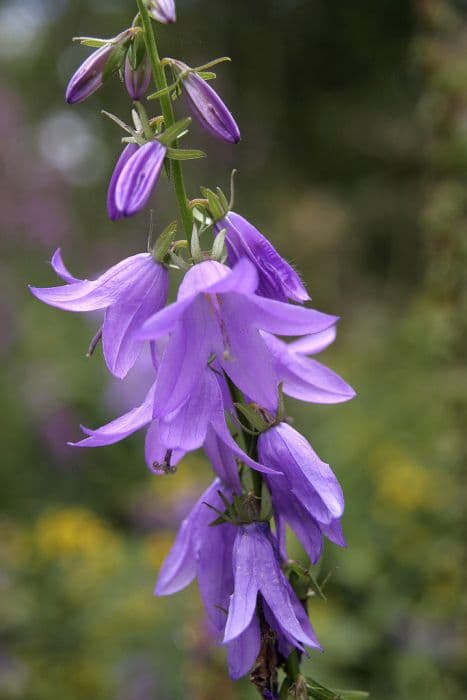Balloon flower Apoyama Group Platycodon grandiflorus Apoyama Group

ABOUT
Apoyama Group is a compact herbaceous perennial to 20cm in height, with blue-green foliage and rich violet flowers 5cm in width, opening from large inflated buds
About this plant
 Names
NamesFamily
Campanulaceae.
Synonyms
Balloon Flower, Chinese Bellflower, Japanese Bellflower.
Common names
Platycodon grandiflorus var. apoyama, Campanula grandiflora, Platycodon sinensis.
 Characteristics
CharacteristicsLife cycle
Perennials
Foliage type
Deciduous
Color of leaves
Green
Flower color
Varies
Height
1-2 feet (30-60 cm)
Spread
1 foot (30 cm)
Plant type
Herb
Hardiness zones
3-8
Native area
East Asia
Benefits
 General Benefits
General Benefits- Ornamental Appeal: Platycodon grandiflorus, commonly known as Balloon Flower, is prized for its distinctive flower buds that swell like balloons before fully opening into star-shaped blossoms.
- Easy to Grow: It is a hardy perennial that is relatively easy to care for, making it suitable for gardeners of all skill levels.
- Attracts Pollinators: The vibrant flowers attract bees and butterflies, aiding in the pollination of the garden.
- Drought Tolerant: Once established, the Balloon Flower is drought tolerant, requiring minimal watering and making it well-suited to low-maintenance landscaping.
- Long Blooming Period: The plant provides a long season of color, typically blooming from summer to early fall.
- Works Well in Various Garden Styles: It can fit into a wide range of garden designs, including borders, rock gardens, and cottage gardens.
- Multipurpose Usage: Balloon Flowers are suitable for cut flower arrangements and as dried flowers, enhancing their value in the garden.
- Non-Invasive: Unlike some perennials, Balloon Flower does not spread aggressively, making it a good neighbor to other plants in the garden.
 Medical Properties
Medical Properties- Anti-inflammatory: Platycodon grandiflorus, also known as balloon flower, is traditionally used for its anti-inflammatory properties, which can help reduce swelling and pain.
- Expectorant: The root of the plant is commonly used in herbal medicine as an expectorant to help clear phlegm from the respiratory tract.
- Cough relief: Balloon flower root has been utilized to soothe coughs and is included in some herbal cough remedies.
- Immune system support: The plant is believed to boost the immune system, although scientific evidence is limited.
- Anti-tumor activity: Early research suggests that extracts from Platycodon grandiflorus may have anti-tumor effects, but more studies are required to confirm these findings.
- Sore throat relief: The root has been used to provide relief for sore throats, likely due to its anti-inflammatory and expectorant qualities.
 Air-purifying Qualities
Air-purifying QualitiesThis plant is not specifically known for air purifying qualities.
 Other Uses
Other Uses- As a natural dye: The roots of the balloon flower can be used to produce a natural blue or violet dye for textiles or artworks.
- In culinary as a garnish: The vibrant blue flowers can be used to decorate salads and desserts to add a pop of color.
- Edible flowers: The flowers of the balloon flower are edible and have a mild sweet flavor, making them suitable for culinary uses in various dishes.
- Crafting: Dried balloon flower stems can be used in floral arrangements, wreaths, and other dried flower crafts.
- Education: Plant can be utilized in botany classes for studying flower anatomy and plant growth habits.
- Garden design: Due to its distinctive shape, it's used in garden aesthetics to provide a structural element amongst other perennials.
- Photography: A popular subject for botanical photographers due to its unique balloon-like buds and striking blue flowers.
- Eco-friendly confetti: Dried and crumbled petals of the balloon flower can be used as a biodegradable alternative to traditional confetti.
- Companion planting: It can be used in companion planting to help protect vegetables from pests, as its strong root system can help improve soil structure.
- Science experiments: The flower's capacity to change color when pH levels in soil change, makes it ideal for classroom experiments on soil chemistry.
Interesting Facts
 Feng Shui
Feng ShuiThe Balloon Flower is not used in Feng Shui practice.
 Zodiac Sign Compitability
Zodiac Sign CompitabilityThe Balloon Flower is not used in astrology practice.
 Plant Symbolism
Plant Symbolism- Endurance and Strength: Platycodon grandiflorus, commonly known as Balloon Flower, is a hardy plant that can withstand various growing conditions, symbolizing the ability to endure and maintain strength through challenges.
- Unfolding of Wishes: As the Balloon Flower's buds swell and open up like a popping balloon, it represents the unfolding of dreams and the realization of wishes, as if it's a visual metaphor for life's surprises.
- Longevity and Eternal Life: In Eastern cultures, the Balloon Flower is often associated with long life and immortality, partly due to its hardiness and the endurance of its blooms.
- Purity and Love: Its striking blue to purple flowers are often seen as a symbol of purity and the sincerity of one's feelings and emotions in relationships.
- Gratitude: The Balloon Flower is also sometimes given as a sign of gratitude or appreciation, likely because of its unique and striking bloom that can be seen as a gesture of thanks.
 Water
WaterThe Balloon Flower should be watered regularly to keep the soil evenly moist but not soggy. During the growing season, water the plant with about one inch of water per week, which is equivalent to approximately 0.623 gallons. Ensure the top inch of soil dries out between watering sessions to prevent overwatering, which can lead cause root rot. In the winter, reduce watering to when the soil is dry to the touch several inches below the surface, adjusting your schedule according to the plant's needs and the humidity.
 Light
LightBalloon Flowers thrive in full sun to partial shade, meaning they prefer at least 6 hours of direct sunlight a day but can tolerate some afternoon shade. The best spot for them is in an area that gets bright morning sunlight and some protection from the intense heat of the midday sun, which ensures vibrant flower production and healthy growth.
 Temperature
TemperatureBalloon Flowers prefer a temperate climate with temperatures ranging between 60 and 80 degrees Fahrenheit for optimal growth. They are hardy plants that can survive minimum winter temperatures down to 20 degrees Fahrenheit but should be protected from harsh cold winds. Ideal temperatures are those that mimic their native habitat, with mild to warm days and cooler nights.
 Pruning
PruningPrune Balloon Flowers to maintain shape and remove spent blooms, known as deadheading, which encourages further flowering. During the spring, cut back any dead or old stems from the previous year to promote new growth. Pruning is typically done after the first flush of blooms has faded, which is often in late summer or early fall, to tidy the plant and prepare it for the next growing season.
 Cleaning
CleaningAs needed
 Soil
SoilThe Balloon Flower (Platycodon grandiflorus Apoyama Group) thrives in a well-draining soil mix containing loam, peat, and perlite or sand to promote good drainage. The soil pH should be slightly acidic to neutral, ranging from about 5.5 to 7.5 for optimal growth.
 Repotting
RepottingBalloon Flowers should be repotted every two to three years or when they outgrow their current pot. Gently handle the roots since they are delicate and do not like to be disturbed frequently.
 Humidity & Misting
Humidity & MistingBalloon Flower prefers moderate humidity levels. It can tolerate some degree of humidity variation, but avoid extremely dry air or overly humid conditions to maintain plant health.
 Suitable locations
Suitable locationsIndoor
Ensure bright light, good airflow, and room temperature for indoor Balloon Flowers.
Outdoor
Plant in sun to part shade, shelter from strong winds, ensure good soil drainage.
Hardiness zone
3-9 USDA
 Life cycle
Life cycleKnown commonly as Balloon Flower (Platycodon grandiflorus Apoyama Group), its life begins with seed germination, occurring in spring when soil temperatures warm. The seedlings develop into rosettes of foliage, and in their first year, they primarily focus on establishing a strong root system and foliage growth. Following the first year, the plant enters a perennial growth phase; in the second year and beyond, it begins to flower in the summer, with buds that swell into balloon-like shapes before opening into star-shaped flowers. After flowering, the plant sets seeds, which are released as the flowers fade and the plant's above-ground parts die back with the onset of autumn. Throughout winter, the balloon flower lies dormant underground, with its roots surviving the cold. With the return of favorable weather in spring, the plant regenerates from its root system to start the cycle anew.
 Propogation
PropogationPropogation time
Late Spring to Early Summer
The Platycodon grandiflorus Apoyama Group, commonly known as the Balloon Flower, is typically propagated by seed. The most popular method involves sowing seeds directly outdoors after the danger of frost has passed in spring. However, for an earlier start, seeds can be sown indoors about 6 to 8 weeks before the last frost date. Provide a light covering of soil over the seeds, as they need some light to germinate effectively. The seeds usually germinate within two to three weeks at a temperature of 70 to 75 degrees Fahrenheit (approximately 21 to 24 degrees Celsius). After seedlings have grown sufficiently and can be handled, they should be transplanted to individual pots to develop a robust root system before eventually planting them in their final outdoor location with adequate spacing to accommodate growth.




![Trailing lobelia [Techno Heat Trailing Light Blue Improved]](/_next/image?url=https%3A%2F%2Fplants-admin.emdemapps.com%2Fimages%2Fplants%2F%2Fimages%2F604b65196de60.png&w=640&q=75)




